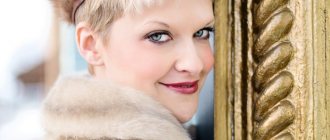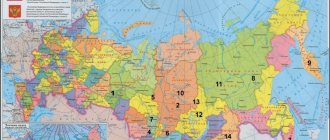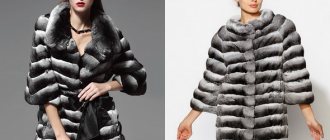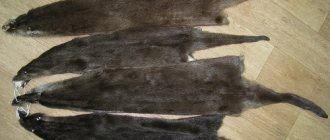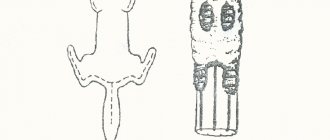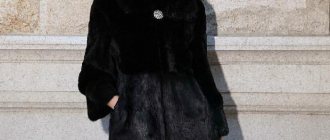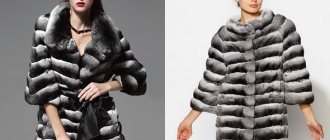At all times, products made from natural fur were worn only by high-ranking officials who had large incomes and could afford such luxury. In addition, outerwear trimmed with fur was an indicator of a person's status. Today, fortunately, you do not need to prove your noble origin or high status to buy a fur coat, but you do need to have a certain income, since fur products are considered an expensive pleasure.
Finding out how many skins are needed for fur coats of different styles
Fur coats made from natural sable fur have always been popular among the fairer sex. Moreover, both young girls and older women showed love for such products equally. But none of the fashionistas ever thought about the number of natural skins that are required to sew one luxurious fur coat. But it’s interesting to know how craftsmen calculate the required amount of fluffy material for sewing a product of medium length.
Be careful!
You should purchase a product made from sable fur carefully, paying attention to even minor details. There is a huge risk of buying a fake.
Certain rules when purchasing:
- Fitting. The product should fit the figure, remain fluffy and comfortable, and not constrain.
- Learning by touch. The fur is delicate and soft, the skin is strong and elastic. If the fur is wrinkled and it makes a crunching sound, it means it is too dry. The service life will be significantly reduced.
- Definition of smell. A fur coat that smells like an animal is not of high quality. The material was used without selection.
- Visual inspection. The seams are even and clear, the threads do not stick out, the lines are not missed, there are no tears.
Sable products last a long time and are expensive, so you should approach the choice carefully and not in a hurry.
Facts about natural fur coats
Mink or sable skin has always been valued among fashionistas. At all times, natural products were sold for a high price, which was justified by their impeccable quality. Outerwear made of natural fur retains heat perfectly and retains its attractive appearance for a long time. Fashionistas are also attracted by the beautiful color scheme, which cannot be reproduced artificially. Natural fur shimmers in beautiful shades in the sun.
Arctic fox fur coat
If we talk about sable fur, it is naturally black, grayish and white. The rarest and most expensive is white fur. Barguzin sable fur is also expensive. Mink dressing is no less popular. Often used for sewing fur coats of different lengths and styles.
Some facts
The skin of this particular animal is very valuable and expensive at different times. Previously, you could buy a huge house for it.
A fur coat made from sable skin has a considerable price, but the quality fully justifies it. The thing keeps warm perfectly and looks great.
The advantage is the color range, from almost black to fawn. The white tint is very rare. Dark sable fur is rated higher. The most expensive is Barguzin, the skin has a light grayish tint.
Mostly famous fashion designers use Russian sable skins for their fur products. Fur coats and short fur coats made from it are not dyed.
To answer the question of how many sable skins are needed for a fur coat, you need to decide what size, length and style you need.
The amount of skin also depends on the breed of the animal; Kamchatka, Tobolsk, and Chikoi individuals are large, Yenisei and Barguzin individuals are small.
Counting the quantity
To accurately calculate how many mink skins you need for a fur coat, you first need to decide on the following data:
- style,
- size,
- the length of the future finished product.
In addition to the parameters of the fur coat, remember that the final number of skins will depend on their size. The smaller the animals, the more mending will be required to sew the product. Craftsmen know another trick that affects the number of skins required for a fur coat. It turns out that female sable and mink are smaller than males. This means that more fur preparations for females will be required than for males.
When calculating how many mink skins are needed for a fur coat, the customer should know that the collar, pockets and other decorative additions increase the number of stitches. Accordingly, the price of the finished product increases.
Statistical data
Humanity has long been engaged in sewing various products from natural fur. The craftsmen even came up with some kind of statistics that show how many skins are needed for a short, knee-length, floor-length fur coat. According to the data, at least 8 skins will be required for a fox outerwear.
- From chinchilla fur, you need about 160-170 skins for a knee-length fur coat.
- A similar product made of sable will require 60 repairs.
- From beaver - 20 skins.
- Of otters - 25.
- For a beautiful knee-length mink fur coat, you need to use the fur of 55 animals.
- To sew a product from squirrel fur, you need to use the skins of 200 individuals.
- A knee-length fur coat of marten fur is created from the skins of 55-60 animals.
Sewing and assembly
One medium-length astrakhan fur coat takes about 17–25 skins. If the fur coat, when unfolded, looks whole, like a single piece, this indicates a good selection of skins in structure and color and shows the high skill of the factory technologist. When sewing a product, the main characteristics of astrakhan fur must be taken into account: shape, size, curl combination, silkiness and shine of the fur. The connection of each astrakhan skin with the neighboring one is individual: the master sews them with a “wave”, “file” or “cut” (depending on the size and shape of the pattern of the skins) according to factory or personal templates. A fur coat can be cut from whole skins or only from paws - this can be understood by turning the fur coat inside out. The latter will cost less.
Lamb fur coat
To sew a beautiful fur coat from lamb fur, you will need to trim 20-30 animals, depending on their size. To sew a product slightly below the hip length - 16-18 skins. A short sheepskin coat will be made from 8-10 skins of young lambs. What does a young lamb fur coat look like? This is the well-known astrakhan fur, which stands out from other furs with its original curls of curls located throughout the trim. To produce products, craftsmen use the fur of three-day lambs. It is at this age that the stuffing is distinguished by its softness.
What is the advantage of an astrakhan fur coat made from whole pieces of fur? This product is warm, wearable and durable. In the color range, astrakhan fur is presented in black, white, gray and brown. Craftsmen recommend using the dressing of Afghan lambs for sewing fur coats. This material is the warmest and most durable. With average financial capabilities, you can give preference to Uzbek karakul. It costs less than the Afghan one, but is not inferior to the first in terms of durability and strength.
We will learn from the video how to correctly calculate the required number of skins for sewing a medium-length fur coat.
Fox fur coats with hood
In order to emphasize your good taste and sense of style, you don’t have to wear a long fur coat - just opt for a comfortable sheepskin coat.
Short fur coat models can be of different lengths:
- Short fur coat, the length of which is above the waistline;
- waist-length short fur coat;
- short fur coat to mid-thigh.
What choice you make depends on your lifestyle and taste preferences. This can be a shortened item in the “autolady” style or a short fur coat of a classic cut. Since it is difficult to choose the optimal headdress for fur clothes, it is better to choose sheepskin coats with a hood.
Despite the density and strength of the pile, a product made from fox fur is quite light, so it is suitable not only for going out, but also for everyday wear. With intensive use and proper care, short fur coats will last from eight seasons or more, delighting with the beauty and shimmer of shiny and elastic fur.
When choosing a short fur coat that reaches mid-thigh, you can successfully emphasize the slenderness of your legs. The width and length of the sleeves add richness and aristocracy to the appearance of the product. The presence of a luxurious hood emphasizes the sophistication and attractive style of the sheepskin coat.
Natural fox fur is represented by three main color types:
- Red is the most popular among buyers, but it is believed that fair-haired girls look especially impressive in it;
- White - rarely used due to impracticality and soiling;
- Black-brown is a popular fur that is preferred by dark-haired fashionistas.
Less common is fox fur in a variety of colors, which are also suitable for creating sheepskin coats, for example:
- Platinum;
- Silver.
If a certain shade does not exist in nature, modern manufacturers are ready to fulfill any fashionista’s whim, using a dyeing technique that will not affect the quality and service life of the product.
Number of mink skins per coat
Our beloved mink fur is endowed with the natural qualities of silkiness and shine. In order to sew a mink coat, animals are not caught in wild forests, as some people think. To sew fur coats, animals are used that were raised specifically for this purpose on a specialized farm. Minks are bred en masse in North America, Russia, and Scandinavian countries. The most valuable fur is considered to be that of a female mink, which is why fur coats made from females are more expensive than those made from males. The price of a fur coat, that is, its value, depends on several factors: size, color, and quality of the skin. Thanks to various methods and methods of breeding, raising animals, and subsequent processing of skins, the range of quantities of mink skins per fur coat becomes very impressive. Most often, mink coats are brown. This is the standard. The fur itself has the property of plasticity, and as everyone knows, it is very resistant to wear. It is thanks to all these properties that manufacturers are happy to sew fur coats of various models for you. If the treatment of a fur coat is raised to the ideal, then it can become a faithful friend for you for a good thirty years. Mink coats themselves are popular not only in our cool country, but throughout the world. After all, this is not just a means of keeping warm, but an indicator of status. It is important that in addition to good heat retention, mink fur is not lost when wet. For people who are lucky enough to live in a harsh climate, a mink coat is an ideal option, and the longer it is, the better. As usual, the fur of males is used to sew hats and collars. It is thicker and denser to the touch. If you sew a fur coat from this fur, it will be quite heavy and not very comfortable. Jackets are often made from the skins of males. The skin is very thick and dense, so it will protect from any frost. It is logical that the price of the skin directly depends on the size of the animal. It is clear that the larger the skin, the more profitable it is to sew from it. Many people are interested in the number of mink skins per fur coat that should be used. We give you the long-awaited answer to this question: in order to sew a mink coat of a classic model, as expected, with a collar approximately knee-length, you will need forty-two female mink skins, or twenty-two male skins.
How to calculate the number of skins for sewing a fur coat from mink, sable, fox, chinchilla and marten?
Many representatives of the fair sex prefer not to buy ready-made fur products in boutiques and stores, but to have them sewn to order in an atelier. Tailored fur coats look much more impressive on their owners. After all, they are sewn taking into account all the individual characteristics of the figure. And they meet all customer requirements. But when it comes to purchasing raw materials for sewing, many have no idea how many skins they will have to purchase in order to have enough for a fur coat.
Before answering this question, you should decide on the fur from which you want to sew a fur coat, as well as the style. If the fur coat is floor length, then you will have to buy an impressive amount of skins for it. If you prefer short models, then naturally, you will need less skins. Separately, it is worth counting the collar, hood, cuffs and belt. They will also get tired of buying more than one skin.
If you have chosen a mink, then it is worth considering that the skins of males and females have different lengths. The male is almost twice as large as the female. However, coats made from female mink fur are considered more attractive and soft. On average, a fur coat of size 44-46 length to the middle of the thigh with a stand-up collar without a hood, cuffs and belt and other additions will require at least 20 skins of a male mink, and twice as many, that is, 40 skins of females. Therefore, products made from female skins will be several times more expensive. Next, to this amount you should add a couple of skins for the collar, another skin for the collar, another skin for the pockets and cuffs. And that turns out to be 24-25 male skins or 48-50 female skins. As the length of the product increases, it is worth adding more skins.
To sew a sable fur coat, you will have to take a few more skins. These animals have no significant differences in size between females and males. On average, one fur product can take from 35 to 90 skins. Everything will depend on the length of the product. If you prefer a short sheepskin coat or a shortened model of a youth fur jacket, then it costs 35 skins to buy. If you want to sew a fur coat of medium length just below the knee, then the number of skins increases to 40-45. Fur coats with a complex cut, such as, for example, coat models, Cleopatra fur coats and bell fur coats, double the number of skins, that is, you will have to purchase up to 90 pieces of fur. If a woman is tall and densely built, then the number can increase significantly. It is also worth paying attention to the professionalism and integrity of the master.
An adult fox raised in a nursery is quite large in size and has a huge fluffy tail. Therefore, to make fox fur coats you need relatively little fur. There are 8 skins in total. This is enough to make a beautiful fur coat up to mid-thigh length. If you want to increase the length further, then buy a couple more skins. The leftovers can be used for a chic fox collar.
The situation with chinchilla skins is completely different. These animals themselves are quite small in size. But at the same time they have very soft and delicate fur, which has gained popularity all over the world. After dressing, the skin remains 12x20 cm in size. The fur on the bellies is very thin. Therefore it is not used. On average, a short chinchilla coat will cost up to 135 pieces. If the length increases to the knee, then you will have to purchase up to 160.
In size, martens are similar to sables. Therefore, sewing a marten fur coat will take approximately the same amount of skins as sewing a sable one. A short fur coat or sheepskin coat will take from 27 to 45 skins. If you want a floor-length fur coat, then buy 80-90 pieces of fur. An autolady coat will require an average of 50-60 skins. Midi length products are made from 60-80 martens.
Fur coats
- How to choose the right quality fur coat: we share tips
Buying a luxurious fur coat is a very exciting and long-awaited event in life...
- A fur coat is an interesting model for interesting women
A fur coat is a rare but quite interesting style of fur coat. If you are looking for a practical...
- Models of sable fur coats
The sable fur coat is rightfully considered one of the most beautiful in the world. In ancient times they even gave it a beautiful name...
- The best tsigeika fur coats: subtleties of choice
A fur coat made from tsigeika is practical, heat-resistant and of high quality. Modern...
Fashion
- At what temperature and in what weather can you wear a fur coat?
Fur items are known to be worn during the cold winter months….
- What to wear with an arctic fox fur coat and what does it look like?
The Arctic fox is a small animal from the canine family. They live in the Northern Hemisphere of our...
- Is it possible to wear a fur coat and jeans?
A fur coat made of natural fur has always been an indicator of the high status and wealth of its owner...
- Tsigeika fur coat: what to wear with it? How does she look?
If you are interested in beautiful fur products that will last more than one season and at the same time...
Care
- Where to find and buy a fur coat cover?
Choosing a cover for a fur coat is a very important point, because the safety of the product depends on its quality. Case…
- Do-it-yourself fur coat restoration: where to start?
If your favorite fur coat has lost its attractive appearance, do not despair!…
- What to do if your fur coat has become too big?
If you find that your favorite fur coat has become too big for you, then this is not a reason to run to the store for something new...
- Why does my fur coat smell and shed?
Have you noticed that your fur coat smells unpleasant or has started to shed? Then you need to figure out what kind of fur it is made of...
Male minks and female minks
The fur of male mink and female mink is very different. Males have a thicker and denser pile, which is well suited for sewing hats and collars. But female minks have softer and sparse fur - it is used for sewing fur coats, coats, fur coats, etc. Approximately how many mink skins do you need for a fur coat? For a classic-cut knee-length fur coat with a collar, you will need at least 40-42 female mink skins or 20-22 male mink skins.
Naturally, the fur of male minks is much more expensive than the fur of female minks, because their skins have very strong and thick skin, the wear of which is higher than the skin of female minks. These skins are used for those areas in the fur product that bear the maximum load. But it is not recommended to sew a long fur coat from the skins of male minks, since the fur product becomes simply heavy and uncomfortable to wear (although wear-resistant and warm).
But mink jackets or short mink coats made from male mink skins show remarkable results. Fluffy, very warm, they will warm you in the bitter cold and save you from the piercing wind. Of course, not every male mink is of great value. For example, the skin of a female North American mink is much more expensive than a male one. Males of European mink, on the contrary, are valued more expensive than females, because the larger the skin, the cheaper the fur product becomes.
The fur of females is more valuable, so expensive fur coats are made from them. The price of a fur coat is influenced by the quality of the skin, color and size. Modern methods of breeding minks and processing their skins lead to a diverse range of products.
Most often the product is made of brown mink. The fur is very plastic and wear-resistant. These qualities enable manufacturers to sew fur coats of various models.
With proper handling and storage, a mink fur coat can last up to 30 years.
Mink coats are popular all over the world. A mink product retains heat well and does not spoil its appearance in wet weather. It is perfect for residents of countries with harsh climates.
Male fur is most often used for sewing collars and hats. It feels denser and thicker to the touch. A fur coat made from such fur will be extremely uncomfortable and heavy. Jackets are often made from the skins of males. Their thick and durable skin will protect its owner in any frost and wind.
The cost of mink skins is also affected by the size of the animal. After all, the larger the skin, the more profitable it becomes to produce products from it.
Many people wonder how many skins are needed for one mink coat. So, for example, for a classic model fur coat with a knee-length collar, you need 42 skins from females, or 22 skins from males.
Preparation of astrakhan skins.
Skin expansion.
If the width of the skin does not fit the pattern in a certain place, for example, at the level of the underfoot, but the length of the skin is more than enough, use a template for expansion. For each set of skins it is built individually.
Fig. 1a, 2a The value of Y (Fig. 1) depends on the depth of the lunge (underfoot) and the color of the astrakhan fur. If there is a strong difference in the color scheme, use this template with great caution. For example, when using a doodle with a white spine and gray sides. In addition, it is necessary to take into account the structure of the hair (this template is especially good for doodles with a ribbed pattern). The X value depends on the width of the lunge (underfoot) and on the possible reduction in length of the skin.
Place the template so that the axes of the middle of the ridge and the middle of the lunges completely coincide on both the sandpaper and the template. Shallow the template, cut it out (Fig. 2) and symmetrically move the left and right halves of the template relative to the ridge to the sides by the amount Y (Fig. 3).
Thus, if the underfoot lunge, for example, is 5 cm in depth and 9 cm in width, take X = 1.5 cm and Y = 5 cm, if the color and structure of the hair allows. Then, after expanding the skin according to the template, it will shorten by 3 cm, but expand by 10 cm.
Skin lengthening.
To lengthen the skin, you can use the same template as for expanding. Only the shift should be made in a different direction and taking into account the new values of X and Y (Fig. 4). The extension template is built in the form of a ladder. In this case, the value of Y depends on the required lengthening of the skin, on the color and structure of the hair.
If, for example, Y = 5 cm, X = 1 cm, then after lifting the template by one step, the skin will narrow by 2 cm and lengthen by 5 cm. If the shift is made by 2 steps, then the lengthening of the skin will be 10 cm, and the steps – 4 cm (Fig. 5).
Having made an individual template for lengthening and widening, be sure to test it on one piece of sandpaper. If there is a strong shift in hair color or structure, change the template.
How many skins does it take to sew a medium-length fur coat?
If you are reading this article, it means that you are thinking about sewing a fur coat for yourself, but you don’t know how many skins you will need for a medium-length fur coat or a fur vest.
Most often, at home, fur coats are made from the skins of animals such as chinchilla, badger, raccoon, mink, rabbit, chinchilla, and fox.
Of course, the length of the fur coat you want to sew will directly depend on how many skins you have and what kind of animal it is, because the size of the skins is different for each of them. For example, you cannot compare fox and chinchilla skins, because fox skins are much larger than chinchilla skins.
Recommendations from experts on the amount of material
For an approximate calculation, experts recommend using the following data:
- If a person’s size is 42-44, then to create a sable vest you will need 6 male skins.
- To sew a standard length fur coat with a hood size 54-56, the master will need about 90 skins.
Based on such data, you can independently take body measurements and approximately determine how many individuals will be needed to make a fur product. But experts also recommend preparing a couple more fish per product. This is due to the fact that during the production process there may not be enough fur, and then choosing a similar shade can be very difficult or even impossible. Moreover, even if the material is superfluous and remains, you should not squeeze it. They can be used to complement a fur coat in the form of a hat or other fashion accessories.
Of course, when choosing a workshop or master, you should know exactly the professionalism, since the quantity also depends on the skill of the seamstress. And if you give the material to inexperienced seamstresses, then the consumption of skins can be significantly greater than when using specially trained craftsmen who have been making fur products for a long time and know all the intricacies of the work.
How many skins do you need for a fur coat?
Also, the number of skins will depend on the length of the fur coat and the finishing. But on average, it takes about 60 pieces of sable skins, 55 minks, 60 pieces of martens, 30 muskrats, approximately 140 chinchillas, 5 wolves, 20 beavers, approximately 200 pieces of squirrel skins, 15 lynxes to make a knee-length fur coat.
How many mink skins are needed for a fur coat?
To sew a good thing you will need high-quality skins and the better quality they are, the less quantity you will need.
On average, it will take 50-60 mink skins to sew a size 48 mink coat. Please note that the size of the animal itself also plays an important role. If these are males, then there will be fewer skins. Females are smaller than males, so you will need more of their skins.
If the style of a mink coat is complex, for example, it has many wedges or it is an A-line silhouette, then more material will be used. Also, when sewing a mink coat, you need to take into account various details, such as the presence of a hood, patch pockets, and a collar.
How many mink skins are required to sew a fur coat?
To calculate the amount of material, it is important to know the dimensions of the future product. The better the quality of the skins, the less they are needed.
On average, it takes about 55 mink skins to make a size 48 fur coat. It is important to take into account the size of the animal itself. Males are larger than females, so less skins will be consumed.
If you plan to sew a fur coat of a complex style, with many wedges, you will need more raw material. The presence of all kinds of parts is also taken into account. These include patch pockets, a hood and others.
How many skins are required?
To calculate the required amount of material, you need to know what type is used and its possible sizes. The fur most often in demand is mink, chinchilla, badger, raccoon, fox, and squirrel.
The following information is not for animal activists. According to statistics, data on how many fox skins are needed for a fur coat are averaged to the number 8. How many skins are needed for a chinchilla fur coat if they are significantly smaller than a fox? This figure is much higher - about 160, and sometimes more. Data for all the most common types of fur are also averaged. To sew a knee-length product you need: 60 sables, 20 beavers, 25 otters, 55 minks, 200 squirrels, 27 raccoons, 5 wolves, 8 seals, 60 martens, 15 lynxes, 135 chinchillas, 50 ferrets, 11 badgers, 30 muskrats, 125 ermines.
Mink
How many mink skins do you need for a fur coat? To correctly calculate the required material, in this case mink skins, you need to know the length and style of the planned model. If the model is shortened, then less, if extended, then more. The number of skins is influenced by the size of the animal itself and the quality of the fur. It is important that there are no defects on it. You will need more females than males as they are shorter.
Fur coats with more skins are valued higher. If 40 male skins are needed, then female representatives need 2 times less.
If the customer chooses a product design option with a collar, the quantity will be increased. The same procedure is performed when adjusting product sizes and taking into account the style.
A new thing made from mink will please its owner for many years, but to create your own fur coat, you need to count on financial investments. The described necessary parameters give an idea of the labor intensity of the manufacturing process of such clothing, the selection of high-quality raw materials, which is reflected in the final amount to be paid.
Rabbit
How many rabbit skins do you need for a fur coat? When selecting rabbit skins, you should also pay attention to the gender of the animal. Males, like minks, are much larger than females and have a richer fur color. Females have another advantage: their fur is softer, more delicate, and color transitions occur smoothly.
How many sables does it take to sew one fur coat?
At all times, products made from natural fur were worn only by high-ranking officials who had large incomes and could afford such luxury. In addition, outerwear trimmed with fur was an indicator of a person's status. Today, fortunately, you do not need to prove your noble origin or high status to buy a fur coat, but you do need to have a certain income, since fur products are considered an expensive pleasure.
Features of sable fur coats
In our country, sable is a traditional fur. Famous rulers and high-ranking officials always wore outerwear trimmed with such material. Today, sable fur coats are among the most expensive on the world market.
Important! There are several breeds of sable, which differ markedly in the texture of the pile and characteristic shades.
In nature you can find different colors of sable: from dark and even black to very light, cream. The most valuable is considered to be black sable with characteristic grayish hairs and a blue tint to the down. The famous Karl Lagerfeld created a fur coat from such fur, the cost of which is 1 million euros.
Products made from this material are very light and do not require additional care. Long service life is considered one of the main advantages of this fur. With proper care, such a fur coat will last 12 years or more.
The price of the finished product varies significantly depending on the breed of fur-bearing animal. Some of them have a truly luxurious stuffed coat, which is distinguished by its unique shine and softness. Others are naturally endowed with a coarser pile and faded shades.
Caring for a sable fur coat
In order for the product to last as long as possible, it should be properly cared for:
- Do not put in bags.
- Use moth repellents.
- Avoid storing near heating objects or air conditioners.
- Hang on hangers.
- Not high humidity in the storage area and sufficient air.
A fur coat must be worn carefully and carefully; the product will not tolerate more than three dry cleanings without negative consequences.
Every female representative wants to feel like a queen - a sable fur coat will help her with this. Therefore, you should not delay your purchase. But how much beauty it will give depends on its care.
How many skins do you need on average for one fur coat?
The number of skins used to sew one product varies significantly depending on various factors. And these are not only the parameters of the person for whom the tailoring is made, but also the characteristics of the material itself.
Important! To sew the skins together, strips of leather or suede are used; with their help, you can easily regulate the number of skins used.
The following significant factors are also responsible for the amount of material:
- Product model. Whether it will be a long, floor-length fur coat or a coat is up to the customer to decide, but the amount of material depends on this.
- Style. Some women prefer a luxurious flared model, while others are content with a small coat. Naturally, the number of skins will differ.
- Human dimensions. Preliminary taking of measurements is very important for calculating the material for sewing; salons usually have standard patterns.
- Skin size. Male fur-bearing animals are much larger than females, so much less such material will be needed than if the material is made from female animals.
Among other things, the presence of a hood, decorative elements, a belt and other components of a fur coat also significantly affects the amount of skins used in sewing.
Number of skins for products
To understand approximately how much material is needed, it is recommended to use standard measurements and the amount of material. Typically, the quantity ranges from 35 pieces to 90 pieces of skins:
- For a short fur coat you will need about 35-40 pieces.
- For a classic fur coat covering the knees, about 45 pieces.
- Full-length coats and fur coats require about 90 pieces of skins.
Why might the quantity change?
Average indicators indicate that for a short or youth fur coat, 30 - 35 skins will be enough, for an average length product it will take about 45 skins, depending on the type of tailoring, and a long floor-length model or a bell-shaped fur coat will require 90 and more cuts of fur. The indicators are highly averaged and depend on a number of factors.
In addition to the size of the person and the skins used, the quantity will be affected by various details of the final product. For example, ¾ or bell-shaped sleeves, as well as a wide collar or large hood. I often sell models with a lot of decorative trim or ruffles along the hem. In this case, the amount of material will be significantly higher.
Fox short fur coat: price
The first question that arises when looking at a bright and alluring red fur cloud is: how much will a fox sheepskin coat cost today? On average, the cost of fox fur coats starts at $250. It all depends on the length, cut, quality and variety of fox fur. Short fur coats made from solid fur plates are more expensive.
Since a short fur coat is purchased for more than one season, perhaps you shouldn’t rush to save money so that the product is truly of the highest quality and is durable. At the same time, if the budget does not allow for luxury, designers offer an extravagant range of sheepskin coats made from sheared fox fur.
